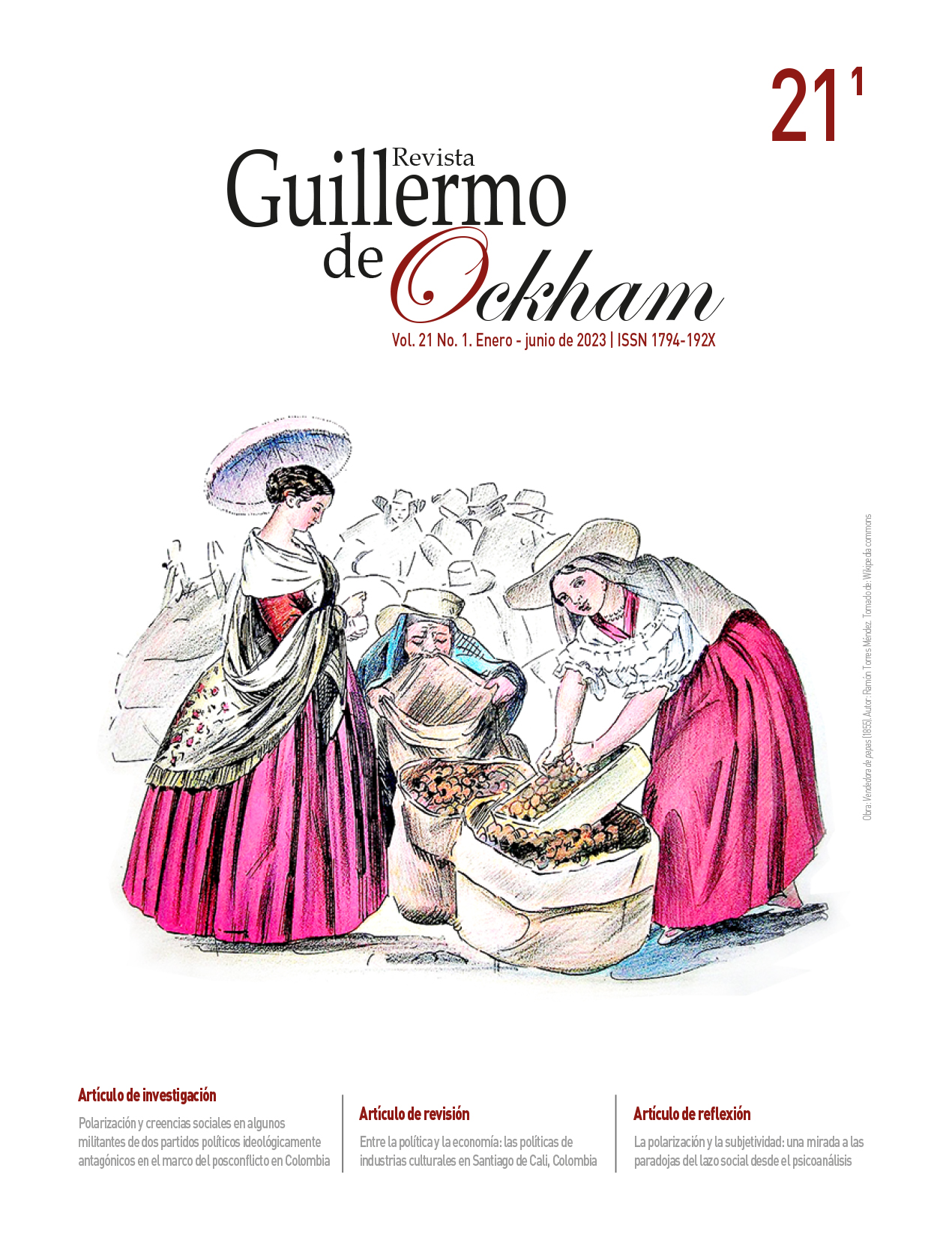La Revista Guillermo de Ockham brinda un acceso inmediato y abierto a su contenido, basado en el principio de ofrecer al público un acceso gratuito a las investigaciones para brindar un intercambio global de conocimiento. A menos que se establezca lo contrario, el contenido de esta revista tiene una licencia con Creative Commons Attribution-NonCommercial-NoDerivatives 4.0 International (CC BY-NC-ND 4.0) http://creativecommons.org/licenses/by-nc-nd/4.0/
- Atribución: debe otorgar el crédito correspondiente, proporcionar un enlace a la licencia e indicar si se realizaron cambios. Puede hacerlo de cualquier manera razonable, pero no de ninguna manera que sugiera que el licenciante lo respalda a usted o su uso.
- No comercial: no puede utilizar el material con fines comerciales.
- Sin derivados: si remezcla, transforma o construye sobre el material, no puede distribuir el material modificado.
- Sin restricciones adicionales: no puede aplicar términos legales o medidas tecnológicas que restrinjan legalmente a otros de hacer cualquier cosa que permita la licencia.
Resumen
La clasificación es una capacidad representacional que le permite a los niños, desde temprana edad, construir categorías con los objetos con los que se relacionan cotidianamente para agruparlos de acuerdo con sus semejanzas y ordenarlos en función de sus diferencias. Este estudio de carácter exploratorio descriptivo, con un diseño transversal, analiza las estrategias de clasificación que utilizan 405 niños de tres, cuatro y cinco años, que viven en sectores urbanos pobres de Cali y Santa Marta. El modelo de análisis microgenético hizo posible identificar las estrategias diferenciadas que emplean los niños en la resolución de un problema que demanda el uso de la clasificación multiplicativa. Los resultados muestran que los niveles de desempeño al resolver la problemática fueron significativamente altos para los tres grupos de edad. La investigación favoreció examinar la complejidad progresiva de los esquemas de acción que subyacen a las estrategias de resolución que exigen el empleo de la clasificación multiplicativa con el propósito de inferir la actividad cognitiva de los niños, documentar el fenómeno de la variabilidad y analizar los procesos de cambio en el pensamiento de los niños preescolares en función de lo que saben y pueden hacer.
Palabras clave:
Referencias
Abrams, D., Rutland, A., y Cameron, L. (2003). The development of subjective group dynamics: Children’s judgments of normative and deviant in-group and out-group individuals. Child Development, 74(6), 1840-1856. https://doi.org/10.1046/j.1467-8624.2003.00641.x
Abrams, D., Rutland, A., Pelletier, J., y Ferrell, J. M. (2009). Children’s group nous: Understanding and applying peer exclusion within and between groups. Child Development, 80(1), 224-243. https://doi.org/10.1111/j.1467-8624.2008.01256.x
Aiken, L. S., y Williams, T. M. (1975). Development of multiple dimension use in form classification. Child Development, 46(1), 123-132. https://doi.org/10.2307/1128840
Atran, S. (1994). Dominios básicos versus teorías científicas: evidencias desde la sistemática y la biología intuitiva Itzá-maya. En L. A. Hirschfeld y S. Gelman (Comps.), Cartografía de la mente: la especificidad de dominio en la cognición y en la cultura (vol. 1, pp. 94-127). Gedisa.
Bernstein, J., Zimmerman, T. S., Werner-Wilson, R. J., y Vosburg, J. (2000). Preschool children’s classification skills and a multicultural education intervention to promote acceptance of ethnic diversity. Journal of Research in Childhood Education, 14(2), 181-192. https://doi.org/10.1080/02568540009594762
Bigler, R. S. (1995). The role of classification skill in moderating environmental influences on children’s gender stereotyping: A study of the functional use of gender in the classroom. Child Development, 66(4), 1072-1087. https://doi.org/10.1111/j.1467-8624.1995.tb00923.x
Bigler, R. S., Jones, L. C., y Lobliner, D. B. (1997). Social categorization and the formation of intergroup attitudes in children. Child Development, 68(3), 530-543. https://doi.org/10.1111/j.1467-8624.1997.tb01956.x
Bigler, R. S., y Liben, L. S. (1992). Cognitive mechanisms in children’s gender stereotyping: Theoretical and educational implications of a cognitive-based intervention. Child Development, 63(6), 1351-1363. https://doi.org/10.1111/j.1467-8624.1992.tb01700.x
Cartwright, K. (2002). Cognitive development and reading: The relation of reading-specific multiple classification skill to reading comprehension in elementary school children. Journal of Educational Psychology, 94(1), 56-63. https://doi.org/10.1037/0022-0663.94.1.56
Caruso, J. L., y Resnick, L. B. (1972). Task Structure and transfer in children’s learning of double classification skills. Child Development, 43(4), 1297-1308. https://doi.org/10.2307/1127516
Cohen, S. A., Hyman, J. S., y Battistini, E. E. (1983). Effects of teaching piagetian decentration upon learning to read. Reading Improvement, 20(2), 96-104.
Farnham-Diggory, S., y Gregg, L. W. (1975). Color, form, and function as dimensions of natural classification: Developmental changes in eye movements, reaction time, and response strategies. Child Development, 46(1), 101-114. https://doi.org/10.2307/1128838
Flavell, J. H. (1993). El desarrollo cognitivo. Visor.
Flynn, E., y Siegler, R. (2007). Measuring change: Current trends and future directions in microgenetic research. Infant and Child Development, 16(1), 135-149. https://doi.org/10.1002/icd.502
Fischer, K. W., y Bidell, T. R. (1998). Dynamic development of psychological structures in action and thought. En R. M. Lerner (Ed.), Handbook of child psychology. Vol 1. Theoretical models of human development (pp. 467-561). Wiley.
Gattuso, B., Smith, L. B., y Treiman, R. (1991). Classifying by dimensions and reading: A comparison of the auditory and visual modalities. Journal of Experimental Child Psychology, 51(1), 139-169. https://doi.org/10.1016/0022-0965(91)90080-C
Hirschfeld, L. A., y Gelman, S. (Comps.). (1994). Cartografía de la mente: la especificidad de dominio en la cognición y en la cultura. Gedisa.
Jacobs, P. I., y Vandeventer, M. (1971). The learning and transfer of double-classification skills by first graders. Child Development, 42(1), 149-159. https://doi.org/10.2307/1127071
Karmiloff-Smith, A. (1994). Más allá de la modularidad. Alianza.
Lovrich, D., Cheng, J. C., y Velting, D. M. (1996). Late cognitive brain potentials, phonological and semantic classification of spoken words, and reading ability in children. Journal of Clinical and Experimental Neuropsychology, 18(2), 161-177. https://doi.org/10.1080/01688639608408272
Micklo, S. J. (1995). Developing young children’s classification and logical thinking skills. Childhood Education, 72(1), 24-28. https://doi.org/10.1080/00094056.1995.10522639
Miller, P. H., y Coyle, T. R. (1999). Developmental change: Lessons from microgenesis. En E. K. Scholnick, K. Nelson, S. A. Gelman y P. H. Miller (Eds.), Conceptual development: Piaget’s legacy (pp. 209-239). Erlbaum. https://doi.org/10.4324/9781410603883
Orozco-Hormaza, M., Perinat, A., y Sánchez, H. (2009). Cognitive development and interaction context. En A. C. Bastos y E. Prabinovich (Eds.), Living in poverty: Developmental poetics of cultural realities (pp. 287-308). Information Age Publishing.
Orozco-Hormaza, M., Sánchez, H., y Cerchiaro-Ceballos, E. (2012). Relación entre desarrollo cognitivo y contextos de interacción familiar de niños que viven en sectores urbanos pobres. Universitas Psychologica, 11(2), 427-440. https://doi.org/10.11144/Javeriana.upsy11-2.rdcc
Overton, W. F., Wagner, J., y Dolinsky, H. (1971). Social-class differences and task variables in the development of multiplicative classification. Child Development, 42(6), 1951-1958. https://doi.org/10.2307/1127597
Pascual-Leone, J., y Johnson, J. (1991). The psychological unit and its role in task analysis: A reinterpretation of object permanence. En M. Chandler y M. Chapman (Eds.), Criteria for competence: Controversies in the conceptualization and assessment of children’s abilities (pp. 151-187). Earlbaum.
Piaget, J., e Inhelder, B. (1976). Génesis de las estructuras lógicas elementales: clasificaciones y seriaciones. Guadalupe.
Platz, D. L. (2004). Challenging young children through simple sorting and classifying: A developmental approach. Education, 125(1), 88-96. link.gale.com/apps/doc/A124940266/AONE?u=anon~8dbcf38e&sid=googleScholar&xid=361ee563
Puche, R. (2000). Formación de herramientas científicas en el niño pequeño. Arango Editores.
Puche, R. (2003). El niño que piensa y vuelve a pensar. Artes Gráficas del Valle Editores.
Rosser, R. A., y Horan, P. F. (1982). Acquisition of multiple classification and seriation from the observation of models: A social learning approach to horizontal décalage. Child Development, 53(5), 1229-1232. https://doi.org/10.2307/1129010
Sánchez, H. (2020). Contextos de interacción educativa y desarrollo de niños preescolares. Summa Psicológica UST, 17(1), 1-10. http://dx.doi.org/10.18774/0719-448x.2020.17.441
Sánchez, H., Paba, C., y Sánchez, L. (2013). Desarrollo de niños que viven en sectores urbanos pobres y sus contextos de interacción educativa. En M. C. Torrado y R. Flórez (Comps.), Primera infancia, lenguajes e inclusión social (pp. 127-148). Ediciones USTA; Editorial Universidad Nacional de Colombia.
Siegler, R. S. (1996). Emerging mind: The process of change in children’s thinking. Oxford University Press.
Siegler, R. S. (2000). The rebirth of children’s learning. Child Development, 71(1), 26-35. https://doi.org/10.1111/1467-8624.00115
Tomlinson-Keasey, C., Crawford, D. G., y Eisert, D. C. (1979). Organization facilitates memory – If you have the appropriate classification skills. The Journal of Genetic Psychology, 134(1), 3-13. https://doi.org/10.1080/00221325.1979.10533393
Turiel, E. (1997). Dominios y categorías en el desarrollo cognitivo y social. En E. Turiel, I. Enesco y J. L. Linaza (Comps.), El mundo social en la mente infantil (pp. 33-70). Alianza.
Wynn, K. (2000). Early numerical knowledge. En K. Lee (Ed.), Childhood cognitive development: The essential readings (pp. 137-147). Blackwell.

 Perfil Google Scholar
Perfil Google Scholar































